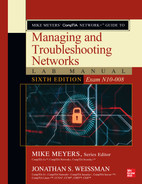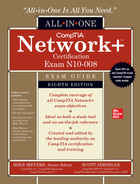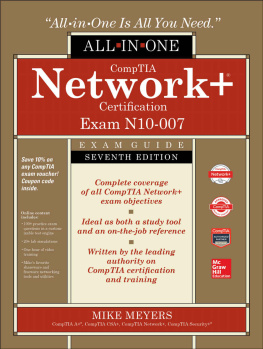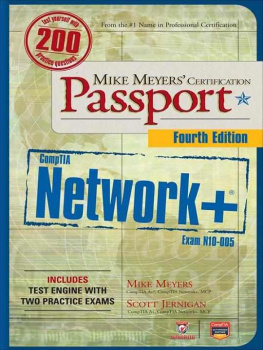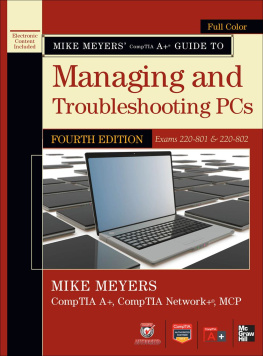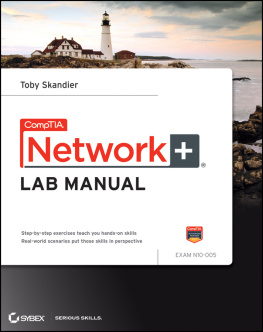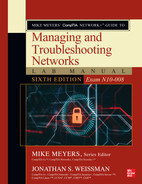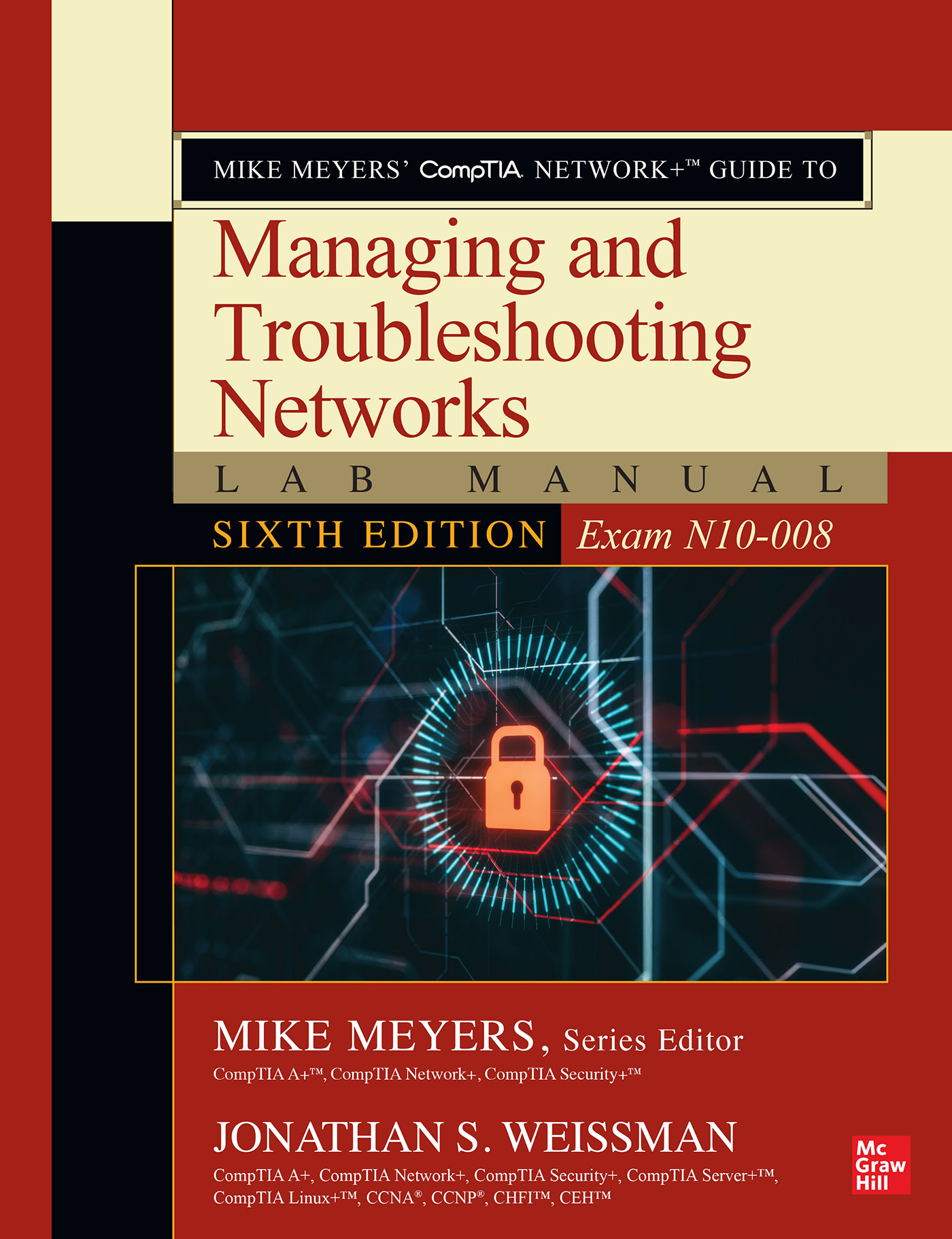About the Series Editor
Michael Meyers is the industrys leading authority on CompTIA Network+ certification. He is the president and founder of Total Seminars, LLC, a member of CompTIA and a major provider of IT fundamentals, PC and network repair, and computer security training and training materials for thousands of organizations throughout the world.
Mike has written numerous popular textbooks, including the best-selling Mike Meyers CompTIA A+ Guide to Managing and Troubleshooting PCs, Mike Meyers CompTIA Network+ Guide to Managing and Troubleshooting Networks, and Mike Meyers CompTIA Security+ Certification Guide.
Mike has attained numerous industry certifications, including CompTIA A+, CompTIA Network+, CompTIA Security+, CompTIA Cybersecurity Analyst (CySA+), and Microsoft Certified Professional.
About the Author
Jonathan S. Weissman is a senior lecturer (Department of Computing Security) at Rochester Institute of Technology, where he was awarded the RIT Outstanding Teaching Award in 2014, the RIT GCCIS Outstanding Educator Award in 2018, and RIT Distinguished Teacher Recognition Program Honors in 2019. Weissman developed and teaches three courses for the edX RITx Cybersecurity MicroMasters program to more than 300,000 students worldwide.
Weissman is also a tenured associate professor and the Networking and Cybersecurity program coordinator (Department of Computing Sciences) at Finger Lakes Community College, where he was awarded the State University of New York Chancellors Award for Excellence in Teaching in 2021.
All in all, Weissman is the recipient of eleven teaching honors and awards. Weissman began his teaching career in 2001 and has taught more than 50 graduate and undergraduate courses, which include networking, cybersecurity, systems administration, ethical hacking/pentesting, digital forensics, malware reverse engineering, cryptography, programming, scripting, Web design, database design, computer organization and architecture, operating system design, and many more. In addition to his two full-time teaching positions, Weissman teaches part-time at Syracuse University (Department of Electrical Engineering and Computer Science) and at Nazareth College (School of Business and Leadership).
In addition to the fourth and fifth editions of this book, Weissman is the author of Principles of Computer Security: CompTIA Security+ and Beyond Lab Manual and Mike Meyers CompTIA Network+ Certification Passport (fifth, sixth, and seventh editions). He also serves as technical editor for many industry textbooks, including this lab manuals corresponding textbook.
Furthermore, Weissman is a networking and cybersecurity consultant for local businesses and individuals. Weissman regularly appears on TV news and talk radio and in articles as a networking and cybersecurity expert. Additionally, he presents at conferences and in webinars, runs workshops, and appears in podcasts.
Weissman has a masters degree in computer science from Brooklyn College and holds 44 industry certifications, including CCNP Enterprise, Cisco Certified Specialist Enterprise Core, Cisco Certified Specialist Enterprise Advanced Infrastructure Implementation, CCNA Security, CCNA, CompTIA Security+, CompTIA Network+, CompTIA A+, CompTIA Linux+, CompTIA Server+, EC-Council Certified Ethical Hacker, EC-Council Computer Hacking Forensic Investigator, and IPv6 Forum Certified Network Engineer (Gold), among many others. He was inducted into the IPv6 Forums New Internet IPv6 Hall of Fame as an IPv6 Evangelist in 2021.
Follow Jonathan S. Weissman on LinkedIn at https://linkedin.com/in/jonathan-s-weissman-058b649b/, Twitter at https://twitter.com/CSCPROF, and Instagram at https://instagram.com/cscprof/. Subscribe to his YouTube channel at https://youtube.com/Weissman52.
About the Technical Editor
Edward Tetz graduated in 1990 from Saint Lawrence College in Cornwall, Ontario, with a degree in business administration. Since that time, he has spent his career delivering certified technical training for a Microsoft Training Center and working as a service delivery professional in both Halifax, Nova Scotia, and Ottawa, Ontario. Over his career, Ed has supported Apple Macintosh, IBM OS/2, Linux, Novell NetWare, and all Microsoft operating systems from MS-DOS to Windows Server 2019, as well as hardware from most of the major manufacturers. Ed currently works for Microsoft in Customer Success in Ottawa, supporting enterprise and government customers.
When not working with technology, Ed spends time with his wife, Sharon, and his two daughters, Emily and Mackenzie.

Copyright 2022 by McGraw Hill. All rights reserved. Except as permitted under the United States Copyright Act of 1976, no part of this publication may be reproduced or distributed in any form or by any means, or stored in a database or retrieval system, without the prior written permission of the publisher, with the exception that the program listings may be entered, stored, and executed in a computer system, but they may not be reproduced for publication.
ISBN: 978-1-26-427473-4
MHID: 1-26-427473-4
The material in this eBook also appears in the print version of this title: ISBN: 978-1-26-427474-1, MHID: 1-26-427474-2.
eBook conversion by codeMantra
Version 1.0
All trademarks are trademarks of their respective owners. Rather than put a trademark symbol after every occurrence of a trademarked name, we use names in an editorial fashion only, and to the benefit of the trademark owner, with no intention of infringement of the trademark. Where such designations appear in this book, they have been printed with initial caps.
McGraw-Hill Education eBooks are available at special quantity discounts to use as premiums and sales promotions or for use in corporate training programs. To contact a representative, please visit the Contact Us page at www.mhprofessional.com.
Information has been obtained by McGraw Hill from sources believed to be reliable. However, because of the possibility of human or mechanical error by our sources, McGraw Hill, or others, McGraw Hill does not guarantee the accuracy, adequacy, or completeness of any information and is not responsible for any errors or omissions or the results obtained from the use of such information.
TERMS OF USE
This is a copyrighted work and McGraw-Hill Education and its licensors reserve all rights in and to the work. Use of this work is subject to these terms. Except as permitted under the Copyright Act of 1976 and the right to store and retrieve one copy of the work, you may not decompile, disassemble, reverse engineer, reproduce, modify, create derivative works based upon, transmit, distribute, disseminate, sell, publish or sublicense the work or any part of it without McGraw-Hill Educations prior consent. You may use the work for your own noncommercial and personal use; any other use of the work is strictly prohibited. Your right to use the work may be terminated if you fail to comply with these terms.
THE WORK IS PROVIDED AS IS. McGRAW-HILL EDUCATION AND ITS LICENSORS MAKE NO GUARANTEES OR WARRANTIES AS TO THE ACCURACY, ADEQUACY OR COMPLETENESS OF OR RESULTS TO BE OBTAINED FROM USING THE WORK, INCLUDING ANY INFORMATION THAT CAN BE ACCESSED THROUGH THE WORK VIA HYPERLINK OR OTHERWISE, AND EXPRESSLY DISCLAIM ANY WARRANTY, EXPRESS OR IMPLIED, INCLUDING BUT NOT LIMITED TO IMPLIED WARRANTIES OF MERCHANTABILITY OR FITNESS FOR A PARTICULAR PURPOSE. McGraw-Hill Education and its licensors do not warrant or guarantee that the functions contained in the work will meet your requirements or that its operation will be uninterrupted or error free. Neither McGraw-Hill Education nor its licensors shall be liable to you or anyone else for any inaccuracy, error or omission, regardless of cause, in the work or for any damages resulting therefrom. McGraw-Hill Education has no responsibility for the content of any information accessed through the work. Under no circumstances shall McGraw-Hill Education and/or its licensors be liable for any indirect, incidental, special, punitive, consequential or similar damages that result from the use of or inability to use the work, even if any of them has been advised of the possibility of such damages. This limitation of liability shall apply to any claim or cause whatsoever whether such claim or cause arises in contract, tort or otherwise.

